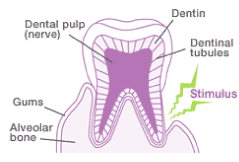Mechanism of Hypersensitivity

Hypersensitivity is a symptom in which, when advanced, your teeth become sensitive or feel pain when stimuli such as temperature or toothbrush bristles are applied to the exposed dentin due to various reasons.
POINTS TO NOTE
- If your teeth are sensitive even though you do not have caries, you may have hypersensitivity.
- Hypersensitivity is caused by recession of the gums due to periodontal disease, inadequate brushing, teeth grinding, or an abnormal bite (occlusion), etc.
What is Hypersensitivity?
Hypersensitivity occurs when the dentin of the teeth becomes exposed due to recession of the gums caused by periodontal disease or aging. It sometimes occurs when the teeth are damaged by inadequate brushing, teeth grinding, or an abnormal bite (occlusion).
Mechanism of Hypersensitivity

The dentin of the tooth contains small tubes called “dental tubules” that connect to the dental pulp (nerve of the tooth). Although not everyone will have hypersensitivity because their dentin is exposed, when the dentinal tubules contained in the dentin open and stimuli such as temperature or toothbrush bristles is applied, the stimuli are transmitted directly to the dental pulp through the dentinal tubules, causing the symptoms of hypersensitivity, including sensitivity of the tooth or pain in an advanced case.
Vicious Cycle of Hypersensitivity
When hypersensitivity progresses to the point where your teeth are sensitive even to light stimulus, you may find it difficult to brush your teeth. However, if you neglect brushing because of sensitivity, plaque will remain on your teeth and your mouth will become unclean. As a result, the dentin of your teeth will dissolve in the acid produced by bacteria in plaque, causing the dentinal tubules to open even more and worsen hypersensitivity.





